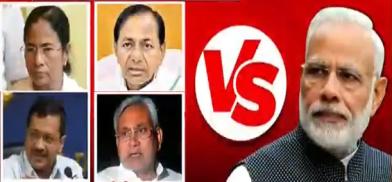Who can take on Narendra Modi in 2024? Contradictions and ego hassles mar opposition unity
Given these roadblocks, it is not a surprise that the BJP, led by Prime Minister Narendra Modi, is a runaway winner in every opinion poll to the dismay of its adversaries who wonder why the economic difficulties of inflation and unemployment are not holding it back

The resignations of Yashwant Sinha and Pavan Verma from the Trinamool Congress underline the restrictive regional aspect of Indian politics. Both of them being from the Hindi-speaking provinces, they may have felt out of place in a predominantly Bengali organization. The linguistic and cultural gaps between the Hindi and Bengali regions are obviously too wide.
It is a feature which can limit the assimilative capacities of parties like the DMK or the Telangana Rashtra Samithi (TRS). Notwithstanding their desire to play a larger role, they will not be able to accommodate any major politician from outside the Tamil- and Telugu-speaking areas.
The Trinamool’s Congress background may have induced Sinha and Verma to try their luck, as has Shatrughan Sinha, a former Bollywood star, who has had greater success in making himself at home in Mamata Banerjee’s West Bengal-bases party. In normal circumstances, the Congress might have been a foster home to those looking for a temporary staging post outside the BJP.
Congress travails
But the Congress is not a normal outfit any more. Its dynastic obligations have tied it so closely to the Nehru-Gandhi family that no one else can expect to play a prominent role in the party. Yashwant Sinha and Verma might have been assets to the Congress whose pan-India background should have enabled the two new members to find a respectable place.
But that wasn’t to be as it wasn’t for Mahua Moitra, whose short stint in the Congress convinced her that it was not a party for an articulate, independent-minded woman, a former investment banker, who was not afraid of speaking her mind. So, she opted for Trinamool.
The Congress obsession with its first family and the regionalism of others like the DMK and the TRS leave an offshoot of the Congress like the Nationalist Congress Party (NCP) and the latest entrant to the non-BJP camp, the Janata Dal (United), as parties which can offer to host anyone seeking a foothold among the secular parties.
Ego hassles of PM contenders
Like the Janata Dal (United), the Rashtriya Janata Dal (RJD) is another of the breakaway group of the defunct Janata Party of 1977 which are now in the secular formation. Both of them are parties of the Hindi belt and, as such, should be able to accommodate Yashwant Sinha and Pawan Verma unlike, say, the Janata Dal (S) of Karnataka whose roots are in the south.
The other outpost of Hindi speakers, the Samajwadi Party (SP), is, like the Congress, too embroiled in its own familial politics of father, son and uncle to have time for newcomers who might like to spread their wings in their capacities as forthright and veteran politicians.
So, it is not only the ego hassles between prime ministerial contenders – the SP’s Akhilesh Yadav has named Mamata Banerjee (Trinamool Congress), Chandrasekhar Rao (TRS) and Sharad Pawar (NCP) as three possible candidates – which frustrate the non-BJP camp’s efforts to put up a united front against its principal opponent.
Given these roadblocks, it is not a surprise that the BJP, led by Prime Minister Narendra Modi, is a runaway winner in every opinion poll to the dismay of its adversaries who wonder why the economic difficulties of inflation and unemployment are not holding it back.
AAP a frontrunner?
The BJP also has other advantages. One of them is its use of the central investigative agencies to harass the opposition parties, and the other is its readiness to entice opportunistic members of the other parties to join the BJP. At present, the BJP has set the investigative agencies on the Delhi ruling party, Aam Admi Party’s (AAP) trail presumably because the BJP sees the AAP as more of a threat than, say, the Trinamool Congress or the TRS or the NCP.
The Trinamool’s latest embroilment in corruption scandals has pushed it very much on the backfoot so far as challenging the BJP is concerned. Neither the TRS nor the NCP can be said to pose a serious political threat to the BJP. The Congress has placed itself out of reckoning in this context by its internal problems which have prevented it from choosing a president.
The AAP, therefore, has emerged as a frontrunner in the matter of taking on the BJP in the 2024 general election. But it is facing resistance not only from the BJP, but also from the Congress which is displeased with the AAP for having helped in bringing down the Manmohan Singh government by siding with Anna Hazare’s anti-corruption movement.
But even as the AAP fancies itself as the BJP’s main opponent, another contender has appeared on the scene, who is probably more formidable than all the others for he has age on his side, a long experience in politics and governance and also influential friends like the RJD.
Nitish Kumar factor
However, if Nitish Kumar throws his hat into the ring, it will create more problems in the secular camp than it will solve. The reason is that nearly all the other aspirants – Mamata Banerjee, Arvind Kejriwal and Chandrashekhar Rao will be deeply upset.
Their unhappiness will please the BJP, but it will know that if the secularists can resolve their differences – perhaps with Maharashtra strongman Sharad Pawar’s help – then the Janata Dal (United) leader and Bihar Chief Minister Nitish Kumar can give the BJP a run for its money.
(The author is a current affairs commentator. Views are personal)










Post a Comment